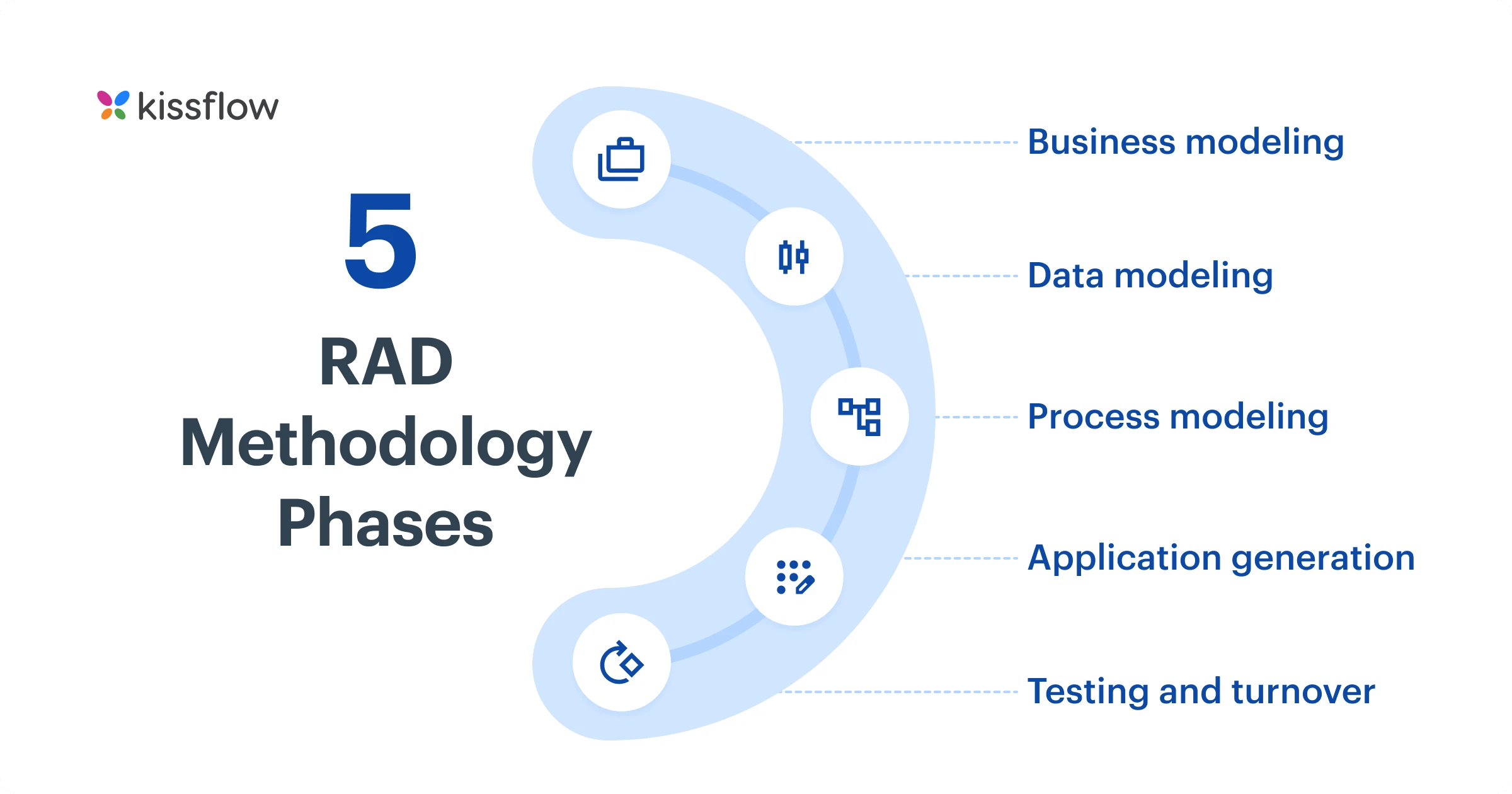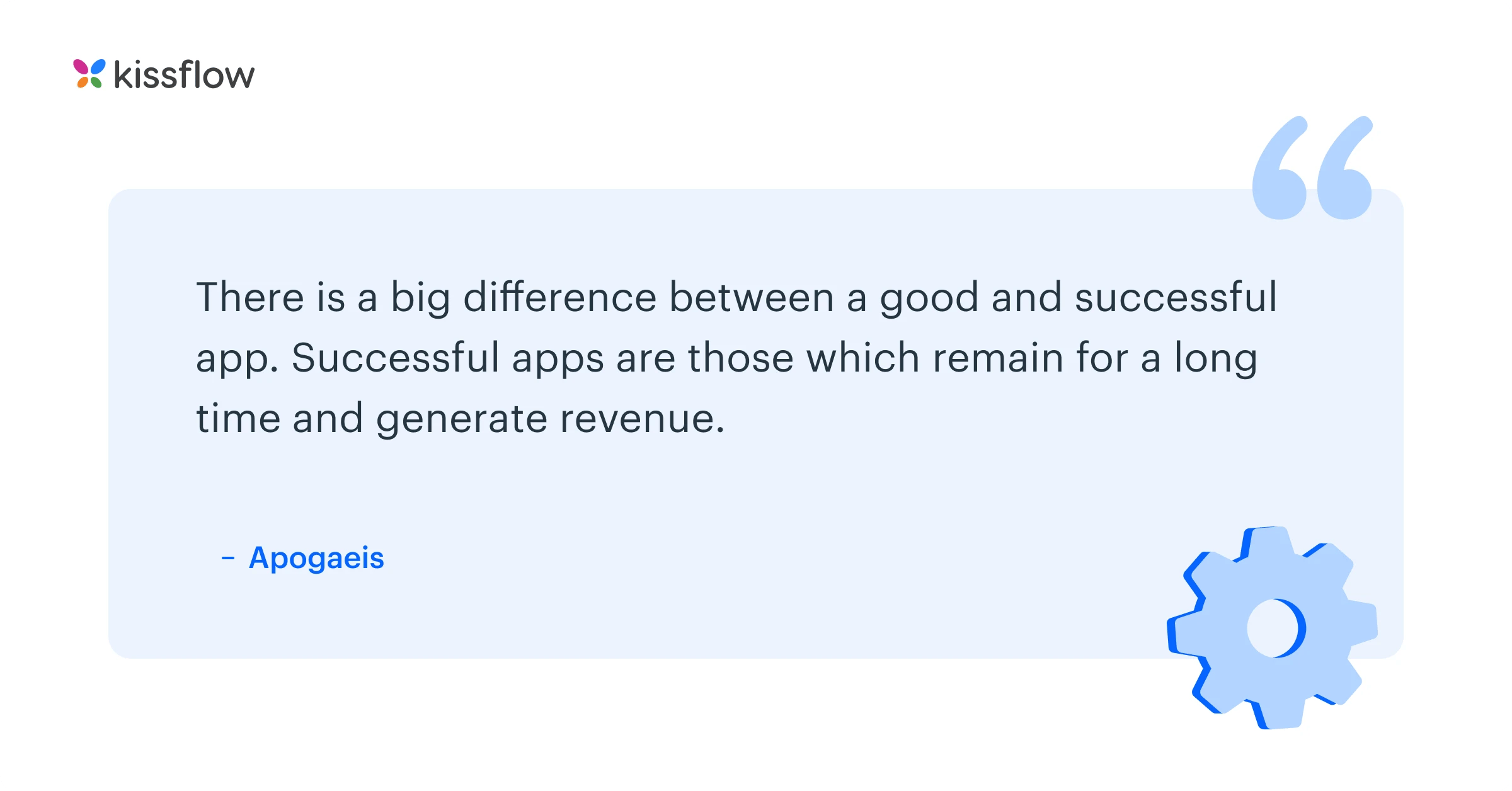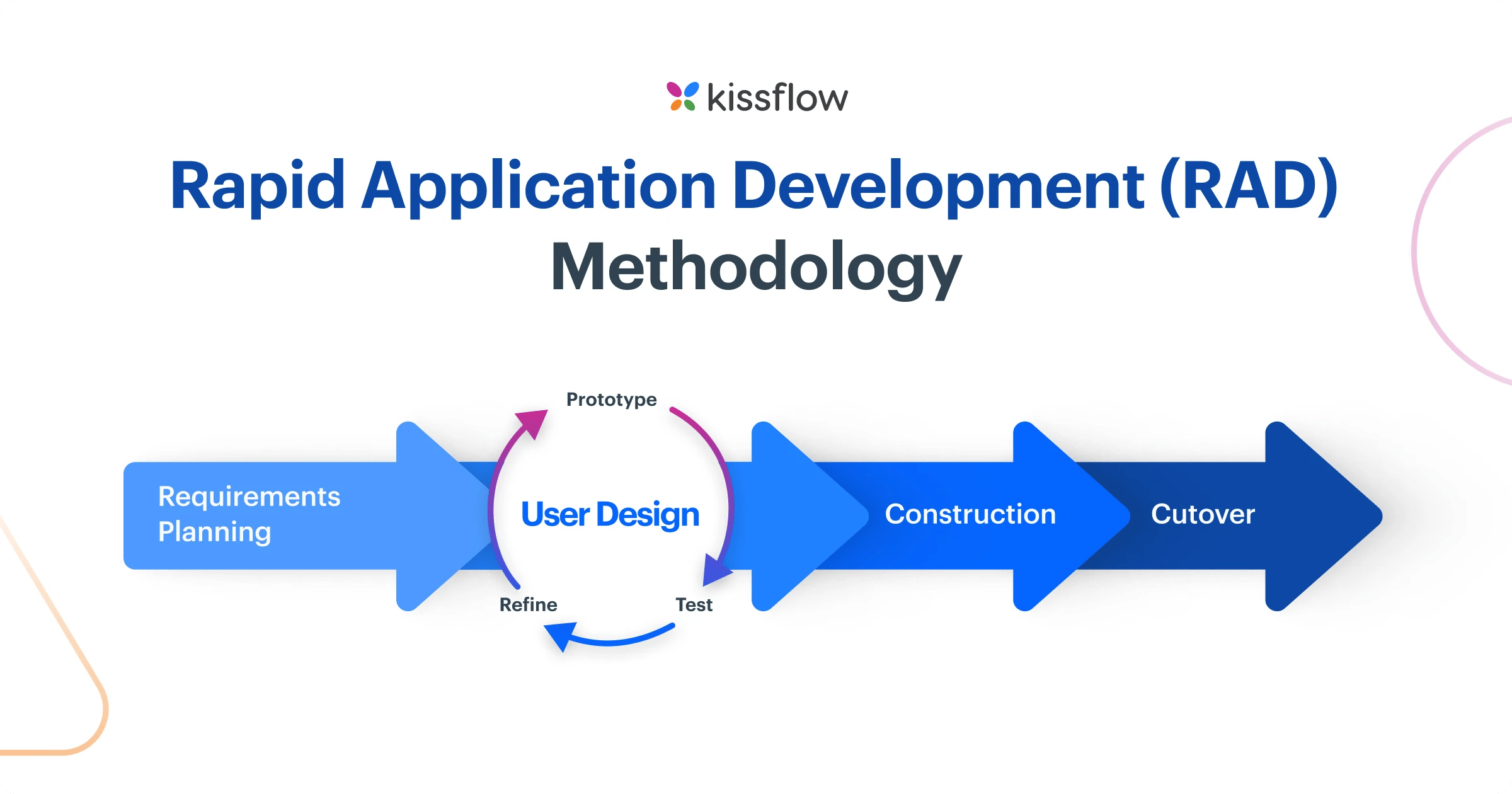
- >
- Application development platform>
- Rapid Application Development (RAD) Methodology
6 Essential Questions to Understand Rapid Application Development (RAD) Methodology
Think of RAD as the secret weapon in the arsenal of every tech-savvy leader. It breaks free from the rigid chains of traditional models like Waterfall, offering a more nimble way to create software. For CIOs aligning IT strategies with wider business goals and BTPs driving transformative IT initiatives, RAD is their guiding light in the fast-paced world of software development.
This blog equips tech leaders with the knowledge to leverage RAD as a strategic tool, empowering their organizations to excel in the digital age.
But when and how did it take the industry by storm? Who introduced it?
What is Rapid Application Development Methodology?
Rapid Application Development (RAD) methodology is a flexible way to create and deploy software applications quickly. The RAD method is effectively designed to adapt to changes and new inputs like features and functions, updates, etc. It is designed to be flexible to changes and to accept new inputs, like features and functions, at every step of the development process.
The term rapid Application Development(RAD) was first coined by James Martin in his book, aptly named Rapid Application Development.
James Martin first developed the development approach in the 1980s when he was working with IBM. In 1991, he formally introduced it as a concept, which was built on the work of people like Barry Boehm.
However, there has been some recent confusion over how rapid application development methodology differs from Agile development methodologies.
What are the five phases of RAD Methodology?

The 5 rad methodology phases include
- Business modeling,
- Data modeling,
- Process modeling,
- Application generation
- Testing and turnover
Why code from scratch when you can build with just a few drags and drops?
Benefits of RAD methodology

"There is a big difference between a good and successful app. Successful apps are those which remain for a long time and generate revenue." - Apogaeis
The rapid application development methodology is perhaps the most effective form of app development that anchors itself on quick delivery, reusable blocks of code, feedback-based development, and rapid prototyping.
50% [1] of organizations will adopt Rapid Application Development (RAD) methodologies by 2024, according to Gartner’s latest research.
Here are the most prominent reasons why RAD can prove beneficial:
- Development cycles are shorter than usual
- Products are built based on client feedback
- RAD uses a flexible approach to accommodate changing requirements
- Customization is not a long-drawn process
- Reusable code blocks make for quicker testing and fewer defects
- Incremental progress is visible and measurable
How Does RAD Methodology Differ From Agile Development?
Because of the similarities between the two, rapid methodology and Agile development have often been thought of as one and the same.
But there are key differences that set each apart from the other.
For a RAD platform, software quality and speed are more important than meeting deadlines. While it’s faster and cheaper to develop software using a rapid application development methodology, it’s not perfect.
RAD methodology is difficult to implement with multiple teams and a large number of developers. But that’s where Agile shines. Agile development is designed to take advantage of a lot of developers on a single project.
Because of this, there are deadlines to meet, and schedules to be adhered to.
To use an analogy, the Rapid Application Development methodology is a 100-meter sprint, while Agile development is more of a marathon. Agile focuses on sustained and continuous progress over an extended period of time. This makes it a better solution for long projects with huge requirements.
Another difference to note is that, in RAD methodology, the primary method of calculating progress is to deliver functional prototypes as frequently as possible. However, in Agile, progress is achieved by delivering a high-quality product at the time of delivery.

How to Choose an App Development Platform for Your Enterprise [ Checklist Included ]
Thank you for downloading!
Why Is Rapid Application Development So Popular Now?
Well, you’re probably looking at the answer right now. With the boom of smartphones and cloud services, there’s been an exponential increase in the requirement for good methodologies to make software quickly and efficiently.
Companies can no longer afford to wait around for months and years to implement a single idea. By the time that happens, they might miss the next best thing and be stuck with a product that no one wants to buy.
Learn more: Best Enterprise Application Development Tools of 2025.
In the old days, custom software was designed for huge corporations with deep pockets. Now, it’s for everyone who has a requirement. This larger audience helps reduce development costs.
With RAD, businesses can create prototypes quickly, gather user feedback, and iterate rapidly—all without the traditional time-consuming processes of web application development.
Rapid Application Development methodology is popular because it helps small teams create software that can quickly adapt to market and customer requirements.
Why code from scratch when you can build with just a few drags and drops?
But Does RAD’s Popularity Mean the End of Traditional SDLCs?
While rapid application development is gaining huge ground with teams to be agile and quick with development, it’s not a cure-all. RAD does not and cannot do everything traditional SDLC can do. For instance, RAD cannot handle long-term development as well as traditional SDLCs can. RAD can be extremely expensive, which makes it infeasible for companies with smaller budgets for their software requirements. RAD is also highly dependent on quick and accurate feedback, which is difficult when you can’t get in touch with your end-users at the drop of a hat.
RAD’s popular, but it’s not the killing blow to traditional SDLC.
Who Uses RAD Methodology?
Companies that work on the cloud thrive with RAD methodology. If you’ve got a product that caters to a large audience, then it makes sense to use rapid application development. Kissflow, for instance, uses RAD methodology for its no-code development for citizen developers.
If you’re thinking of using Kissflow to create your own apps, you don’t have to spend weeks and months finding a way to get them to work. All you need is the idea and the logic–with just these, you can get started creating your app. If there are any changes, you can make them quickly and–crucially–without breaking the whole thing.
RAD Methodology in the Real World
Take a look at the cloud service industry right now. The thousands of products you see aren’t custom-built. They’re designed to be accessible to a wide range of companies and clients. But that doesn’t mean they’re one-size-fits-all.
Going back to our example, Kissflow is a cloud workflow automation platform where you can create your own apps using RAD methodology. This is an example of a platform where rapid methodology is used to create apps quickly and efficiently.
This isn’t the only platform to do this. Platforms like Zoho Creator, Outsystems, etc., all let the user create apps according to their own requirement.
Rapid Application Development has changed the trend of how software is developed. Here’s how developers are shifting from slow to speed.
How Can I Implement RAD Methodologies in My Team?

For starters, you want to have a small team. Large teams don’t work well with rapid application development frameworks. That’s because there’s a constant need for communication. That doesn’t work well with larger teams, which can be inflexible and difficult to communicate with.
Learn how to effectively implement RAD in your organization by exploring our Rapid Application Development Framework.
If you’ve got a program to create, follow these rapid application development steps.
- Plan requirements
- User design
- Rapid prototyping
- Feedback and transition
The last step is where you’ll need to keep your eyes on the ball. Feedback will need to be quick and constant, from both the client and your developer team. That feedback goes back into prototyping, allowing you to create new functions and features with each prototype. When everything is finalized, the final product is created, tested, and delivered to the customer.
For a comparative analysis of RAD, Waterfall, and Agile methodologies, read our article: RAD vs. Waterfall vs. Agile: Which One Is Best for You?.
FAQs on RAD methodology
1. Does my team have what it takes to implement RAD?
RAD is an intense methodology that needs a high level of commitment. Additionally, RAD requires a team of skilled developers and engineers who can work at pace.
2. Does my client support RAD methodology?
RAD is a client and feedback-centric method of application development. It requires clients to commit to frequent review meetings and feedback sessions to ensure the product aligns with their requirements.
3. Is my client committed to the development timeline?
For RAD to succeed, clients need to be understanding of the time frame of the project and need to be made aware of any changes or delays. Clients will also need to be proactive in making trajectory-based decisions.
4. Do I have the right tools to implement RAD?
Implementing RAD requires an intuitive app development solution that helps developers structure each phase of app development, collaborate efficiently, and define roles and responsibilities with precision. Kissflow’s low-code RAD platform is perfect for organizations looking to build an effective RAD framework without long implementation times.
Conclusion
5. What are the core principles of RAD?
Core principles of RAD include iterative prototyping, heavy user involvement throughout development, small dedicated teams, timeboxed development cycles, and reusable components. RAD emphasizes functionality over documentation and prioritizes getting working software in front of users quickly to gather feedback and make improvements in real-time.
6. How does RAD improve development speed?
RAD improves development speed through iterative prototyping that gets working software in front of users quickly, allowing early feedback and course correction. Joint Application Development sessions bring stakeholders together to gather requirements efficiently. Reusable components eliminate the need to build common features from scratch. Time-boxing development cycles prevents scope creep and maintains momentum.
7. What industries benefit most from RAD?
Industries benefiting most from RAD include software-as-a-service companies needing to validate market fit quickly, e-commerce businesses responding to rapidly changing consumer behaviors, financial technology firms navigating evolving regulations, healthcare organizations implementing patient-facing applications, and manufacturing companies developing internal operational tools where user feedback is critical to success.
8. How does RAD compare to traditional development models?
RAD differs from traditional development models by emphasizing working prototypes over comprehensive documentation, involving users throughout the development process rather than just during requirements and testing, using iterative development cycles instead of a linear approach, and prioritizing speed and functionality over comprehensive features. RAD typically produces initial results faster but requires more active stakeholder involvement.
9. What tools support RAD methodology?
Tools supporting RAD methodology include visual development environments with drag-and-drop interfaces, prototyping platforms for quickly creating functional demonstrations, collaboration tools for gathering stakeholder feedback, reusable component libraries that accelerate development, automated testing frameworks to maintain quality during rapid iterations, and deployment automation to quickly move from development to production.
Rapid application development is a concept that can be difficult to adhere to for some companies. If your company relies on multiple teams coordinating with each other for a single project, then it’s difficult to incorporate RAD software into those situations. But if you’ve got the agility to cycle between prototyping and feedback quickly–if you’ve got talented developers ready to change anything immediately–then it’s worth giving rapid application development a shot.
If you’re thinking of automating and streamlining your workplace for rapid application development, give Kissflow Software a shot. You can create your own apps or customize existing apps to your requirements.
Conclusion
Kissflow's low-code platform plays a significant role in RAD. It provides a user-friendly visual approach, allowing users and IT teams to build applications quickly and efficiently.
One of the main features of Kissflow is its low-code capabilities. Users can leverage pre-built, customizable code blocks to construct applications from scratch. This feature enables users to develop and modify enterprise-grade apps without extensive coding knowledge, making the process more accessible and efficient.
Furthermore, Kissflow platform is designed for swift prototyping and feedback during the development and testing, ensuring flexibility and efficiency. This approach keeps the app development process as fast as possible, a key characteristic of RAD methodology.
In addition, Kissflow's platform allows users to automate business processes using RAD principles, enabling the creation of automated apps at a rapid pace, with no coding required in some cases.
Discover how the Kissflow Low-Code App Development platform can streamline your development process.
Kissflow is an effective tool for organizations looking to implement a RAD framework without lengthy implementation times, making it a perfect fit for businesses aiming for agility and speed in their application development process.
Ready to bring your applications to life with the power of RAD?
-3.webp)
How much could your organization save with low-code?
Get the impact of a low-code/no-code platform on your application development costs
Related Articles

![What is Rapid Framework? | How it Speed Up App Development? [New]](https://kissflow.com/hs-fs/hubfs/rapid-application-development-RAD-thumb.jpg?width=352&name=rapid-application-development-RAD-thumb.jpg)










